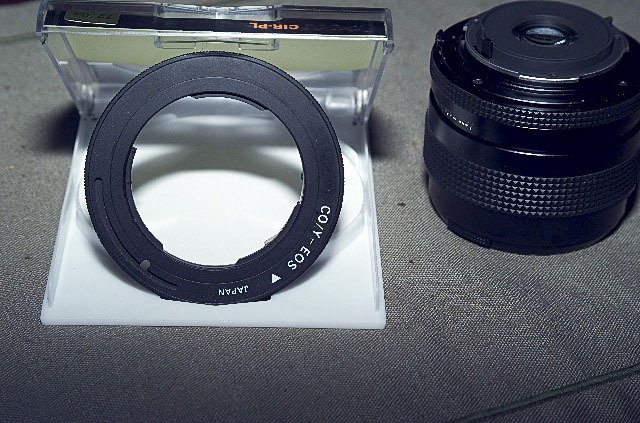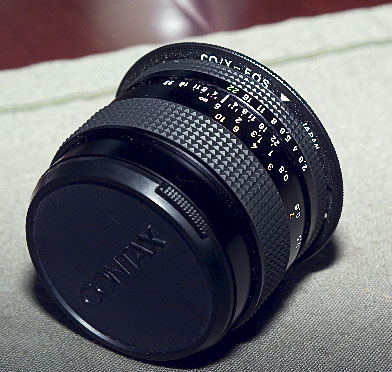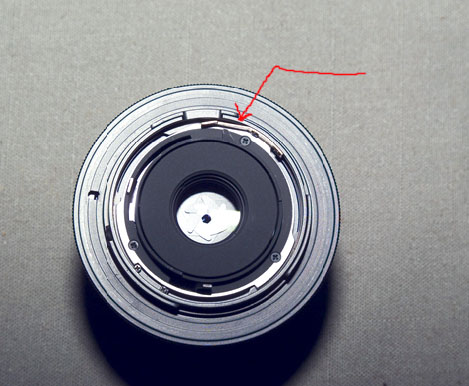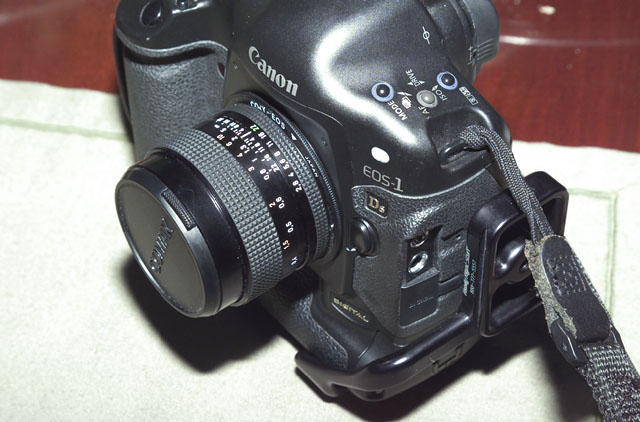As an outdoor scenic photographer, I am always looking
for a solution that will allow me to get the best possible resolution
from my camera. In my case this is the Canon 1Ds or my older Kodak
560. In my work I tend to favor wide angle lenses starting at 35mm
and going all the way to the 20mm range.
My first Canon lens was the 24-70L F2.8. I was very pleased with this
lens, especially in the 24mm to 35mm range. However in the first year
I was carrying it, I often would find that I was mainly staying around
the 28mm focal length. The 24-70 is a fairly large and heavy lens so
I decided to check out the Canon Primes that were available. This would
allow me to save in both bulk and weight. Plus most photographers will
agree that a prime lens at any focal length is always sharper than
a zoom lens.
I quickly eliminated the Canon 35mm F1.4 and 24mm 1.4. Both are great
performers but they are rather large and expensive. I then moved to
the Canon F2.8 28mm and 20mm but after reading many user reports on
these two lenses, I decided that they were not going to provide the
higher resolution I was after. Many of the reports I read actually
favored the resolving power of the 24-70L lens over the Canon 28mm
F2.8. It was about this time that some web posts caught my eye in regards
to using the Contax Distagon lenses on Canon cameras. The ability to
use these non-Canon lenses is allowed because of some interesting facets
in regards to the Canon body design.
First of all, Canon uses a larger diameter with their lens opening
with a shorter retro focus distance (the distance from the exit pupil
to the film plane). In layman’s terms, if you want to design
an adapter for a 3rd party lens, if that lens has a greater retro focus
distance; it’s not a hard thing to do. There is space available
to allow for the thickness of the adapter, without it becoming an extension
tube. In fact it’s easier to use non-Canon optics on the EF mount
rather than the older Canon FD lenses. The FD and EF mount have very
close if not identical retro focus distances. The FD mount used a breech-lock
mount; the EF mount uses the modern bayonet style mount. To create
an adapter to go from FD breech-lock to EF bayonet mount would require
a thicker adapter, than a non-Canon Bayonet mount. The thicker adapter
would tend to act like an extension tube and thus you would lose infinity
focus.
Because of this, you can pick from a large number of non-Canon optics;
Nikon, Contax and Leica are the ones that come to mind most often.
There is another advantage for Canon users. With many of Nikon’s
current digital bodies, the older AI Nikkor’s will not meter,
an exception to this is the new D2H. The older AI Nikkor’s
were mostly manual focus but had some of the best glass that Nikon
ever made. In the last 2 years, the number of the AI Nikkor’s
on eBay has grown tremendously and a good shopper can get some great
deals.
If you use a non-EOS lens on a 1Ds there are a few issues that you
have to contend with.
1. Manual focus
2. Metering
3. An adapter to go between the non-EOS lens and the Canon body
Let’s cover each of these issues.
Manual focus
To some this is a big issue especially an event shooter or a sports/action
shooter. For me it’s really a “non issue”. This is
especially true with some of the Contax Distagon wide angle lenses
as they have such a reach of range at infinity. I have heard the expression, “With
a distagon at infinity, anything from your toes to the furthest tree
in the distance will all be in sharp focus”. The Contax Distagon
28mm F2.8 for example at infinity focus is sharp from 5 feet out. I
personally feel that for close up work manual focus is not an issue
either as I tend to always be in non-AF mode when I work close up.
However if I am shooting birds, I am always in AF mode which is one
reason I haven’t scooped up an old Nikon F2.8 400 AI by now.
Metering
This is a more critical subject. The ability to get good information
to the camera in regards to ambient lighting is very important. When
you first put one of these non-Canon lenses on your EOS body, it’s
quite a shock when you look for your aperture setting on the top LCD
and see a 0.0.
Basically the vast majority of these adapters will allow you to work
with your EOS body in M mode and Av mode. All the metering modes such
as spot and center-weighted will still work. However since you no longer
have an EF lens on your EOS body, there is no automatic stop down.
So to meter correctly, you manually set your shutter speed, then physically
stop down the lens. I would recommend you focus first with the lens
wide open to allow the maximum amount of light into the camera to assist
you. Then stop down the lens and meter. This will take some getting
used to and don’t be surprised if you take a few shots that are
all washed out since you forgot and left the lens wide open.
I have also discovered that over time, you will gain a feel for the
particular lens and metering will become easier. This is because as
you use this setup you will begin to anticipate what settings will
work for the given scene. Another advantage to digital is you can always
check your work in the LCD by viewing the image, histogram or both
The non-EOS Lens adapter
There are many companies that currently market 3rd party adapters
for the Canon system. Be aware that all of these are niche players
in that usually the entire company will consist of one to five people.
This means you most likely will have to deal directly with the company
and lead times can be excessive. You also have to trust them to produce
an adapter that won’t damage the contacts on your Canon body.
It’s also important to make sure that the company you pick has
produced the adapter out of solid materials and that it’s well
machined. The tolerances of a modern camera are very slim and if one
of the contacts doesn’t line up correctly this could lead to
either damage or a err99. You also want to make sure that the adapter
locks securely to your lens and has no play once it’s installed.
Some of the adapters currently on the market are listed below.
Novoflex (Nikon to EOS)
Bob Shell Adapters (Contax to EOS)
Cameraquest adapters (Contax/Nikon/Lecia and medium format to EOS)
Zoerk Adapters (Medium format to EOS)
I choose to work with the Cameraquest adapter for Contax to Canon
EOS for my work.
The Cameraquest Adapter & Distagon Lenses
The basic Cameraquest adapter will slip in-between your Canon body
and the lens. I found that for me it works better to mount the lens
to the adapter, and then mount that combination to the camera. Remove
it in reverse order. The Cameraquest adapter has a small lever/cam
that you press in to release the lens from the adapter. In the pictures
below you can see the adapter, the adapter mounted to the lens, and
adapter/lens showing the release lever. The lens in this case is a
Contax Distagon 35mm F2.8.

Image of the Cameraquest EOS-Contax adapter

View of the Contax distagon lens and Cameraquest adapter

Red arrows points to release lever
Once you have mounted it you will hardly know you have anything there.
The adapter itself takes up a very small amount of space. Cameraquest
makes their adapters from material that is as strong as the Canon lens
mount metal. Notice in the image below, since the adapter is black
it blends in with the camera very well.

Canon 1Ds with Cameraquest/Contax lens mounted
The Contax Distagon lenses have a huge cult
following. After hearing about how sharp they were on the 1Ds, I had to try one. I picked the
28mm F2.8 for my testing. The lens itself is small and compact with
easily read markings on the outside. The focus ring and aperture rings
are made with good grips and locating them while operating the camera
is an easy task. The lens is threaded for a 55mm filter ring.
Here are all the Distagons that Contax makes that I am aware of.
18mm F 3.5
21mm F 2.8*
24mm F 2.8
28mm F 2.0*
28mm F 2.8*
35mm F 2.8
* Superior performers in this series. (Based on other photographers
reports and my own testing)
You can still purchase most of these lenses new, however they are
found all over the web used or from brokers like KEH camera. I purchased
all of mine used over the web.
What to expect?
This is a fair question after all you just put a much older piece
of technology on the 1K - 7K camera you own. My results were stellar.
Here are my results when I tested the Contax 28mm F2.8 Distagon against
my 24-70L EOS lens. I kept my aperture at F11 or F8 on both lenses
and all my testing was done outdoors, at some of my favorite locations.
1. The 28mm F2.8 Contax was sharper all the way to the corners on
every shot. When looking at the various test images I found that the
center areas of each image were very close from both the 24-70L and
the Contax Distagon 28mm. But when you looked at each image at a 100%
view, often times, you would see the sharpness fading on the images
taken with the 24-70L as you moved out to the corners. This wasn’t
true with the Contax Distagon.
2. I was never able to get the Contax 28mm F 2.8 to produce CA (Chromatic
Aberration) even in extreme lighting situations. The 24-70 tended to
produce CA much more often especially when fine objects were against
the sky like fine tree limbs.
3. With the Contax 28mm any normal height filter mounted tended to
vignette (darkened in the corners). The 24-70 with a two stack of normal
height filters didn’t. To get around this, I started using my
72mm filters on the Contax 28mm. I used a 72mm to 55mm step down ring
to accomplish this.
4. In most situations the Contax 28mm was slightly cooler in all colors
than the Canon 24-70L lens. This was most noticeable in the greens.
The color issue is an easy correction and in many cases, I found I
preferred the Contax colors anyway.
5. The Contax 28mm Distagon at F8 or F11 hardly ever needed a focus
correction as anything from 5.5 feet or out was sharp. With the 24-70L
Canon, I found that I had to often make focus corrections for the foreground
over the background and bracket the images later in Photoshop. This
is a common problem with all wide angle zooms.
The conclusion for me was that the Contax Distagon 28mm was a “keeper” and
has become a permanent addition to my bag. Since I mainly used the
24-70L in the 24-35mm range, I quit carrying it in the field and have
come close to selling it a few times recently. Since I started this
process, I have added several non-Canon lenses to my collection. Some
of these are:
Nikkor AI 50mm 1.4
Contax Distagon 28mm, 35mm both F2.8
Contax Planer 50mm 1.4
Mamiya 35mm F 3.5
Nikkor 45mm F2.8 (Tessar design)
Currently I would have to say that in my outdoor work, I use non-Canon
glass at least 85 to 90% of the time.
Pros
- Expands your investment in a Canon system by allowing you to work
with some very good non-Canon Glass
- Price point on these non-Canon
lenses is very reasonable
- The Contax Distagon Wide Angle Series
produce Amazingly Sharp/crisp/detailed images
- You can carry several
of these lenses and have less overall weight/bulk in your pack
Cons
- Loss of Autofocus
- Metering only will work in Av and M mode on most
Canon Bodies
- Most of the adapter companies are niche players
Acknowledgements
Many thanks to Stan Disbrow for his help on the discussion of the
Canon Mount and the optical issues of non-Canon lenses.
Sources for further information
Zoerk Adapters---- www.zoerk.com/
Bob Shell Adapters--- www.bobshell.com
Cameraquest Adapters--- www.cameraquest.com/
Novoflex adapters--- www.novoflex.com/html_d/index_d.htm
Please feel free to ask me any questions directly. I can be reached
at the following email address: pcaldwe@aristotle.net
www.photosofarkansas.com
|